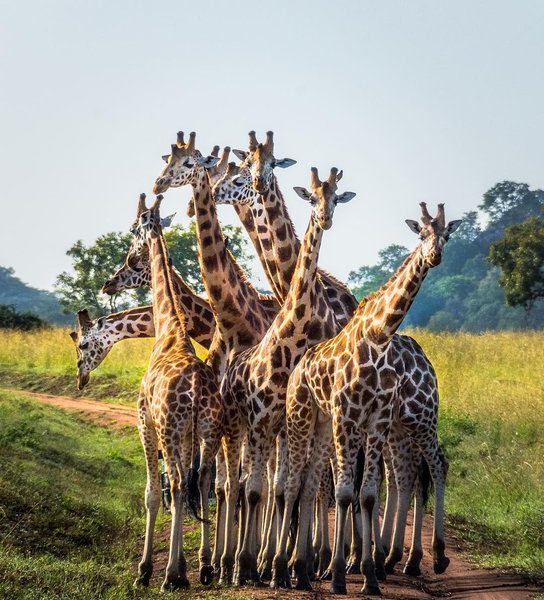Giraffes translocated to Pian Upe Wildlife Reserve by Uganda Wildlife Authority
Five critically endangered Nubian giraffes were translocated from Murchison Falls national park (Uganda’s best-known and biggest nature reserve) to Pian Upe Wildlife Reserve on 28 October, according to Uganda Wildlife Authority (UWA)
This relocation was the first batch of Nubian giraffe into the Pian Upe Wildlife Reserve, as part of the Uganda Government wildlife conservation body ambitious effort to save the species from extinction.

Uganda Giraffe Photo Credit: IG/larsemil1
The translocation exercise will see a total of 15 giraffes (5 male and 10 females) reintroduced into the Pian Upe Wildlife reserve. In addition to giraffes in Pian Upe, in 2018 UWA translocated 92 Impalas into the reserve. The three week giraffe translocation exercise will enhance the long-term survival of the species; restore natural biodiversity and long-term economic benefits to the entire wildlife conservation value chain. It will also enable communities with cultural attachment to the giraffe to participate in its conservation, enhance the conservation value of Pian Upe Wildlife Reserve by reintroducing one of its indigenous species that had become extinct there and diversify tourism products with associated ecological and economic benefits and re-enforce/supplement dwindling populations to enhance biodiversity and ecosystem balance and utilization.
Uganda Wildlife Authority short for UWA, is the governing bodies that regulate wildlife conservation in Uganda. UWA manages 10 national parks, 12 wildlife reserves, and 14 wildlife sanctuaries across the East African country.
In 2015, Uganda Wildlife Authority (UWA) translocated fifteen Nubian giraffes from Murchison Falls national park to Lake Mburo national park in western Uganda, as part of the conservation UWA efforts to diversify the wildlife animal species in Lake Mburo National Park as well as create a safe population of the Uganda giraffe.
Dr. Panta Kasoma, representing the Chairman Uganda Wildlife Authority Board of Trustees presided over the release of the giraffes in the Pian Upe wildlife reserve. Present was a member of UWA Board of Trustees Mr. Leonard Wamakote, UWA management, leaders of districts neighbouring the Pian Upe reserve and community members.
Dr. Kasoma says “We now have giraffes in Pian Upe after very many years and we hope this will further enhance tourism in the reserve”. He further added that in addition to increased tourism other benefits such as employment, sale of food and crafts as well as accommodation, increased revenue sharing and other indirect economic benefits will be realized.
Uganda Wildlife, Hiking & Trekking Tours tours to Karamoja region combine tour to the Mount Napak, Karamoja’s third highest mountain and known for its steepness and lush vegetation that makes it the toughest mountain to climb. Due Mount Napak unique location within the Pian Upe Wildlife Reserve, visitors experience breathtaking panoramic views of the Karamoja planes and distance mountain ranges, in addition unique wildlife during guided walking safaris in the wildlife reserve
The translocation of Giraffes in Pian Upe wildlife reserves was conducted by the non-profit Giraffe Conservation Foundation and Chayenne Mountain Zoo in the United States, in partnership with Uganda Wildlife Authority (UWA). Uganda Wildlife Conservation Education Centre (UWEC) and Makerere University were also participating in the exercise.
ABOUT PIAN UPE WILDLIFE RESERVE
Pain Upe Wildlife Reserve is the largest Wildlife Reserve and the second largest Protected Area (after MURCHISON FALLS NATIONAL PARK) in Uganda. The wildlife reserve covers an area of 2,043 km
Pian Upe is located in Nakapiripirit and Amudat districts and bordered by Napak, Katakwi, Kumi, Kween, Bulambuli and Bukedea districts.
ABOUT GIRAFFES IN UGANDA.
Giraffe live primarily in savannah and their height allows them to eat leaves and shoots located much higher than other savannah animals can reach, offering them a different food supply. Males can grow up to 6 metres in height. They mainly look out for Acacia trees.
Their long neck is a feeding adaptation that enables them to obtain food that others can’t thereby reducing competition with other animals.
Their long tongues are also helpful in pulling leaves from thorns and their long legs allow them to run fast from potential predators.
Giraffe are quite peaceful; they do not form territories and they are quite social as they live in loose herds ranging from one to over one hundred animals.
The major threats to the giraffe population are humans, who illegally kill them for their skin, meat and hair on the tail.
Like other savannah animals, giraffes are susceptible to diseases, which are also a threat.
Predators such as Lions also view giraffes as prey so they need to protect themselves from this potential predator.
History has not been kind to the giraffes in Uganda. Rinderpest wiped out the giraffe population in Ankole region, while in the north and north eastern of the country, the giraffe population decimation was largely a result of civil unrest, trophy hunting and poaching for meat. These incidents led to local extinction of giraffe in Matheniko by the end of 1968 then Bokora and Pian Upe by the end of 1996.
These threats have now been greatly reduced by law enforcement in Uganda protected areas, significant veterinary monitoring and improved community relations.
In 2015, a re-introduction of 15 giraffes was done in Lake Mburo National Park, and 2016 -2017, 36 giraffes were translocated from Northern side of Murchison Falls National Park to the southern side.
In 2018, 14 giraffes were translocated from Murchison falls national park to Kidepo Valley National Park. All these successful translocations have since registered births and their populations have increased hence boosting giraffe numbers nationally.
Join us on a 3 Day Pian Upe Game Reserve, Mount Napak, Uganda Hiking & Trekking Tour. Get in touch now; Email info@responsibletourismcompany.com

